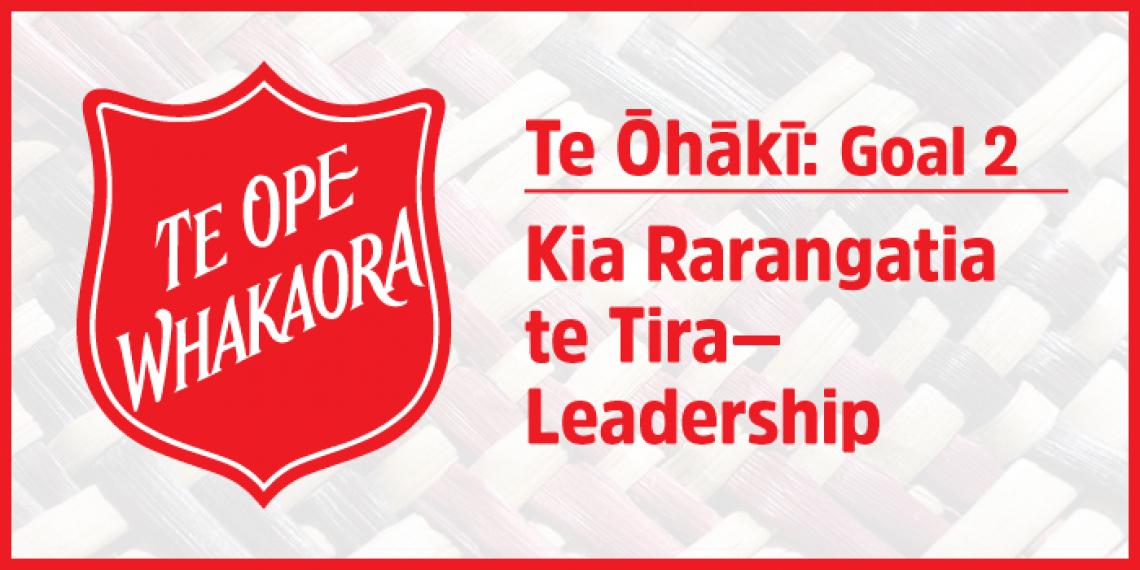You are here
Te Ōhākī: Kia Rarangatia te Tira — Leadership

Goal 2: Kia Rarangatia Te Tira – Leadership
‘Our development plans make a greater investment in Salvation Army Māori leadership to intentionally develop Māori leaders in preparation for senior and strategic roles.’
Te Ōhākī, our Māori Ministry Strategic Plan, has been in place for two years. It has started an important conversation in The Salvation Army that has had both expected and unexpected consequences. The expected consequences include a demonstrable increase in training around the motu (country) at all levels—from corps to the governance table, greater use of the language of biculturalism in our activities, and attempts at all levels to build enduring relationships with tangata whenua.
The most important unexpected consequence is that our Māori Salvation Army members have felt empowered to ask about their own tino rangatiratanga (self-determination) within the Army and the challenge of balancing our Salvation Army’s hierarchy with Māori community leadership structures.
We celebrate the progress being made, but it is clear we still need to work together to realise a pathway for tino rangatiratanga within The Salvation Army and, in particular, to continue our conversations about leadership.
Doing Mission Together
To achieve the optimum results from Te Ōhākī it is important all aspects of The Salvation Army in Aotearoa New Zealand become aware of, and involved in, the outworking of this strategy—from territorial headquarters, divisional headquarters and nationally-managed programmes to the corps and centres within the communities where we serve.
Honouring the Treaty
The Salvation Army’s work with Māori (known in New Zealand as tangata whenua, ‘the people of the land’) needs to be understood in the context of both the place of spirituality in the life and culture of tangata whenua then and now, and the centrality of New Zealand’s founding document, the Treaty of Waitangi.
Mana Māori
Historically, there was no sense in which spirituality was a separate or optional part of life for Māori communities—and in many senses this persists for contemporary marae communities. This means Māori communities are open to religion and spirituality and have a language to engage in those debates and discussions. However, this also means that Māori communities tend to integrate new expressions into their existing community life, rather than transform their community in line with new spiritualities and religions.
Weaving together
The whāriki is an important symbol of community in te Ao Māori. In our Māori Ministry strategic vision, the whāriki symbolises the weaving together of tikanga and Christianity.
Our conviction is this weaving together will allow Māori within The Salvation Army and those we are in relationship with to flourish into their full potential. The master strand that holds our whāriki together is Christ, and our relationship with him gives us full freedom to express our identity, our relationships and discipleship as tangata whenua.
Ideas for developing Māori leaders
- At territorial, executive and divisional levels: To see a Treaty partnership model expressed in a tangible way in leadership positions at all levels in the Salvation Army. As our bicultural relationship becomes better informed we are seeing a deliberate emergence of leadership transparency in corps, divisional, national and territorial settings. For example, Māori representation at governance level, in territorial councils, through divisional secretaries, with corps Māori Ministry, and in Mana Whenua engagement.
- At Booth College of Mission: To see Booth College of Mission implement training models for Māori that include more intentional bicultural training in their onsite training programmes and a wānanga-based stream of training for officership/leadership and other corps responsibilities. For example, ‘Te Whare Io’ is a Māori discipleship programme currently being conducted at Booth College of Mission by external facilitators, an exciting development.
- Building cultural intelligence: Recognising that tauiwi (non-Māori) Salvationists continue to wrestle and at times struggle with biculturalism, ongoing training will therefore need to be provided on biculturalism and its implementation. For example, identifying suitable candidates for vacant roles of Divisional Secretaries/Leaders for Māori Ministry requires a conversation between divisional leadership and Territorial Secretaries for Māori Ministry for bicultural consistency.
- Recruitment strategy: Although there are capable Māori leaders in The Salvation Army, there is not yet sufficient Māori leadership to strengthen The Salvation Army’s bicultural culture. Working alongside the Territorial Secretaries for Māori Ministry and the Māori Ministry Council, an intentional recruitment strategy for improved bicultural relationships should identify gaps in the territory and divisions, as well as the required skills so we can seek out people to fill any vacant roles.
Christ’s final wishes
An ōhākī refers to someone’s last words before death. Christ’s final words in the Great Commission were that all believers would go forth and make disciples of all nations, baptising them in the name of the Father and of the Son and of the Holy Spirit.
It is a sadness that around the world—including in Aotearoa New Zealand—these words have been used as a tool of colonisation, rather than as an imperative to build relationships that transcend culture, ethnicity, race and all other barriers.
Te Ōhākī is a call to The Salvation Army to put whakawhanaungatanga (creating connectedness and relationship) at the heart of our faith and our life together. In this way we will truly honour both the founding treaty of our nation and the final words of our Lord and Saviour, Jesus Christ.
by Lieut Tau Mataki (c)
- Read the Māori Ministry Strategic Plan